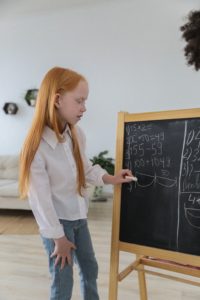Helping students learn to think about the processes they use to solve problems is an area of interest for me these days. I have been reading a lot about the different ways to help students understand problem solving in mathematics and the different kinds of thinking they need to do to be effective problem solvers and appliers of mathematics.
It is not an easy task to get students to reflect on the decisions they make in problem solving or to evaluate the effectiveness of a strategy they chose to use to solve a problem. There are lots of variables in play and for a student to be able to concentrate on solving a complex problem while at the same time worrying about the process they are going through to solve the problem is difficult. It is difficult for adults to do while teaching or learning on their own, and we are much more experienced learners.
As I reflect on my teaching of problem solving and read about the different strategies that have been recommended by researchers, it is becoming very clear to me that a metacognitive routine is critical in mathematics classes. Students need to learn early in their educational career how to think about how they solve complex problems, what learning strategies work best for them, how they adapt what they are learning to new situations, and those questions will not be answered without a lot of help from their teachers.
I know as an educator that I need to reflect on every lesson, in-service, or training that I do so that I can make it better each time. I need to reflect on what worked best with the participants; what I did to prepare so I can do the same thing or change if the approach was not successful; and listen to the evaluations of participants so that I get a variety of inputs. All of these things are not easy; all take time to do; and all require and understanding of and willingness to adapt what I’m doing so I can get better at what I do.
Not only is it a difficult task to reflect and learn from ourselves, it is difficult because many of us were never taught to do this, and therefore struggle to help others reflect, analyze, and learn from themselves. Dr. Wong Yoong (2002) talks about the different ways students learn and process information and advocates that if mathematics is useful it is important that we make them (students) pliable learners of mathematics.
There are lots of ways for teachers to embark on supporting metacognitive processes in their classrooms, but making several simple instructional routines a part of a teacher’s repertoire would make the process easier to manage and successful:
- Think aloud- making a teacher or student’s thinking available to others as they think out loud as they solve a problem
- Teacher monitoring student’s processes- have student brainstorm a way of getting started on a complex problem, let them work for a while, stop the class to discuss effectiveness of this approach and decide next steps.
- Student’s monitoring their own processes in small groups- similar to the above strategy but students take control of their own discussion in small groups
Another set of strategies is to have student’s keep reflection journals that have them reflect on their learning styles, and the instructional approaches/activities they are using in class:
- What new ideas/concepts/skills have I learned?
- What was the most difficult part of this unit?
- What did I do to overcome the difficult parts?
- What did we do this unit that was most effective for me? Why?
More specific reflections about problem solving-
- What strategy did I use to solve this problem? Why did I choose this method?
- What do I think the answer might be? Why? Was I right/close? Why/why not?
- If I struggled with solving this problem, what decisions do I need to make first to make progress next time?
- What would I do differently next time to be more effective? What would I do the same?
Since it is January and a new semester is beginning, I thought it was appropriate to talk about inserting a new instructional routine. We know that most routines are established within the first 7 weeks of the school year, but a new semester is a good time to implement additional routines or to tweak old ones. It is my sincere hope that your students do more thinking about their own thinking as the semester proceeds; I know I will continue to think about my own learning and how I can be more effective in working with the teachers and students I have the opportunity to support.
Wong, K. Y. (2002). Helping your students to become metacognitive in mathematics: A decade later. Mathematics Newsletter, 12(5). Available from http://math.nie.edu.sg/kywong
Schoenfeld, A.H. (1987). What’s all the fuss about metacognition? In A.H. Schoenfeld (Ed.), Cognitive science and mathematics education (pp. 189-215). Hillsdale, NJ: Erlbaum.
Images: Monstera, Pexels.com; Pixabay, Pexels.com
Original Post: January 8, 2010, updated January 25, 2022
